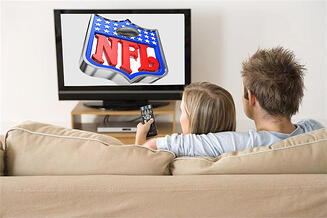 If you’ve never lived in Boston, you might not understand the spectacle that is September 1st. It’s the day that most new leases start, which means it’s the day almost every person in the city moves into a different apartment. U-Hauls crowd the narrow streets, abandoned furniture sits on the sidewalks, and new neighbors begin to pack into the halls. This year, as I watched boxes being lugged around, I couldn’t help but feel relieved that I didn't have to move. While moving itself is a chore, apartment hunting is the more challenging part of the process—should I go in for a one bed or a two bed? Should I just pay another $150 per month and get additional square footage? Or should I stay firm and stick to my original budget? And this is the most agonizing question of all: if I let this apartment go, will I regret it? The process is exhausting, and even though you know you'd make the very same choices if you were to go through it again, there is no sense of triumph in the final decision made. Why is that?
If you’ve never lived in Boston, you might not understand the spectacle that is September 1st. It’s the day that most new leases start, which means it’s the day almost every person in the city moves into a different apartment. U-Hauls crowd the narrow streets, abandoned furniture sits on the sidewalks, and new neighbors begin to pack into the halls. This year, as I watched boxes being lugged around, I couldn’t help but feel relieved that I didn't have to move. While moving itself is a chore, apartment hunting is the more challenging part of the process—should I go in for a one bed or a two bed? Should I just pay another $150 per month and get additional square footage? Or should I stay firm and stick to my original budget? And this is the most agonizing question of all: if I let this apartment go, will I regret it? The process is exhausting, and even though you know you'd make the very same choices if you were to go through it again, there is no sense of triumph in the final decision made. Why is that?
Think about it: what makes a house hunt different from the many other choices we’re faced with on a regular basis, such as buying a can of soup or a light bulb? Besides needing to deal with a real-estate agent, the key difference lies in how the choices are presented to us. In one situation, we are presented with choices sequentially (you see one house at a time), whereas in the other situation, we’re shown all the options at once (you choose a can of soup from an array of options at the store). So why does this matter? According to a study by Cassie Mogilner, Baba Shiv, and Sheena Iyengar, the way in which we are presented with choices has a considerable impact on how happy we are with the chosen option and how committed we are to that choice.
In one of the experiments conducted, researchers showed participants descriptions of five gourmet chocolates and asked them to choose the one they wanted to taste. One group of respondents (sequential choosers) was shown the chocolates one at a time, while the other group (simultaneous choosers) was shown the chocolates all at once. Once participants selected a chocolate and sampled it, they were each asked individually to complete a survey and indicate how satisfied they were with their choice.
The result? Participants who were presented with the options one at a time were less satisfied with their choice than the participants who considered all the options at once. More interestingly, “sequential choosers” were also more likely to switch to a different option when given the choice to swap for a randomly selected option about which they knew nothing, indicating lower levels of commitment among this group.
The reason? As you might expect, the regret of having passed up “better” options plays some role, but researchers found that this goes away once the chooser is allowed to pick from previously seen options. What really drives lower satisfaction among “sequential choosers” is the feeling of “hope.” According to the research, sequential choosers know that alternatives will become available in the future, so they tend to “imagine a better option, hoping it will become available.” This focus on other possible options leaves them less happy with their selection. In contrast, “simultaneous choosers” remain focused on the options in front of them, and, as a result, are more satisfied and ultimately more committed to their choice.
What does this mean for businesses? When deciding how to present your products to consumers, it is worth noting the impact that this could have on their commitment to the products. This research clearly shows that allowing consumers to evaluate all their options simultaneously (vs. one at a time) results in higher levels of satisfaction. This, in turn, impacts product returns/cancellations, customer loyalty, and advocacy for the brand.
What does this mean for market researchers? When designing concept test exercises, it is important to understand the impact that sequential vs. simultaneous presentation will have on consumer satisfaction and commitment ratings to the chosen option.
As for me, while I can’t change how options will be presented the next time I look for a house, I now understand the inherent limitation of the process. . . and that the “best one” may be the one I have in hand and not one yet to come.
Ramya Parameswaran is a Project Manager at CMB. She is passionate about consumer marketing and is always on the lookout for new insights on what drives consumer choice.




 Lindsay is an Associate Consultant at South Street Strategy Group.
Lindsay is an Associate Consultant at South Street Strategy Group. How many times have you done your favorite thing? It doesn’t matter what your favorite thing may be, or if your favorite thing varies by season. Just think of the number. Does it seem lower than you would expect? Does it seem higher? Or, does it feel just right?Have you ever been to Walt Disney World 50 times? I have. And I continue to go every year. Why? That’s an excellent question and even though, at this point, I have a fairly automated response to that very question, people still don’t seem to understand.
How many times have you done your favorite thing? It doesn’t matter what your favorite thing may be, or if your favorite thing varies by season. Just think of the number. Does it seem lower than you would expect? Does it seem higher? Or, does it feel just right?Have you ever been to Walt Disney World 50 times? I have. And I continue to go every year. Why? That’s an excellent question and even though, at this point, I have a fairly automated response to that very question, people still don’t seem to understand.
 If you live in a city, you probably know about the current battle between Uber car services (and others) vs. taxi companies. Maybe you’ve seen stories in the news or actually found yourself in the middle of a taxi driver protest yourself—like the one that happened
If you live in a city, you probably know about the current battle between Uber car services (and others) vs. taxi companies. Maybe you’ve seen stories in the news or actually found yourself in the middle of a taxi driver protest yourself—like the one that happened 
 One of my major motivators in life is receiving free stuff. You can often find me walking around Costco looking for samples or signing up for loyalty programs just for the bonuses. So, when I recently started using Birchbox, a monthly subscription service that sends a box of expensive beauty product samples each month, I was ecstatic to learn that I could earn rewards points for reviewing each product in the box. Birchbox’s use of points seems to be working; with around
One of my major motivators in life is receiving free stuff. You can often find me walking around Costco looking for samples or signing up for loyalty programs just for the bonuses. So, when I recently started using Birchbox, a monthly subscription service that sends a box of expensive beauty product samples each month, I was ecstatic to learn that I could earn rewards points for reviewing each product in the box. Birchbox’s use of points seems to be working; with around  Amazon has actually confirmed that Vine reviewers act differently than non-incentivized reviewers, but not perhaps the way you might think. On average, Vine reviewers give lower ratings than non-Viners. That being said, Amazon research shows that
Amazon has actually confirmed that Vine reviewers act differently than non-incentivized reviewers, but not perhaps the way you might think. On average, Vine reviewers give lower ratings than non-Viners. That being said, Amazon research shows that 